Unveiling the Essentials of Speed and Agility Training
In this article, we will explore how speed and agility training can transform your performance, offering practical exercises and insights to boost your fitness.
Did you know that top athletes in sports like soccer and basketball attribute up to 80% of their success to speed and agility? These two attributes are not just buzzwords in the world of sports; they represent the foundation of high-level performance and can be the deciding factor between victory and defeat in critical moments. Imagine the difference between a soccer player who can sprint past defenders with ease and one who struggles to keep up. Or think about the agility of a basketball player who can seamlessly change direction to evade a block. These skills are vital and can be developed through targeted speed and agility training.
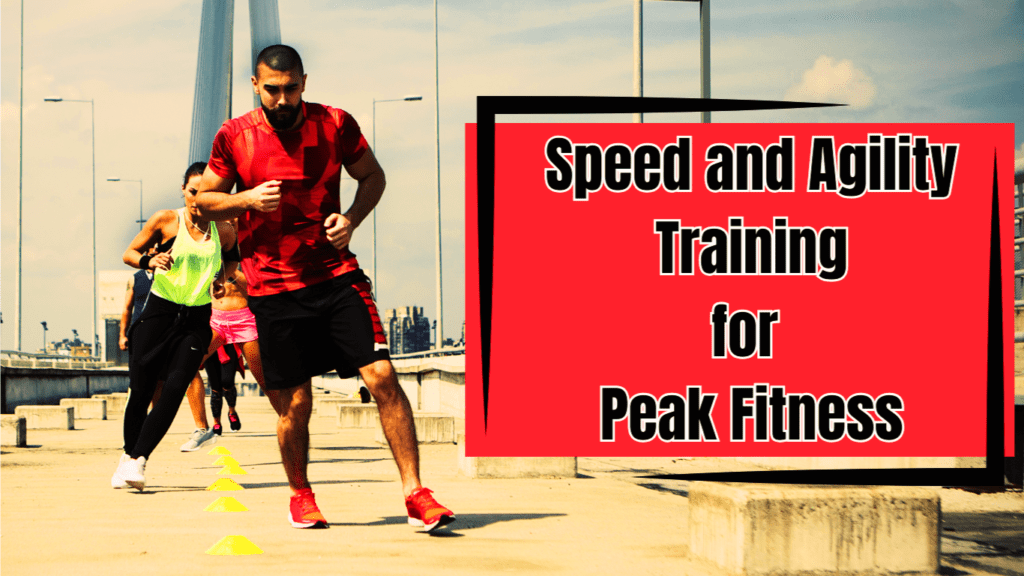
The concept of speed and agility training is crucial for athletes across various disciplines. Speed refers to the ability to move quickly from one point to another, which is essential for sprints, fast breaks, and any action requiring rapid movement. Agility, on the other hand, involves the ability to change direction rapidly while maintaining control and balance. This combination is indispensable in sports where quick reflexes and sudden changes in direction are required. But the benefits of speed and agility training extend beyond the realm of professional sports.
Speed and agility training can significantly enhance overall fitness and improve functional movement in everyday life. Consider how these attributes play a role in daily activities: whether you’re catching a bus, playing with your kids, or simply navigating a crowded space, having improved speed and agility can make these tasks easier and more efficient. Furthermore, these skills contribute to better coordination, reduced injury risk, and a more active lifestyle. Therefore, integrating speed and agility training into your fitness routine can lead to noticeable improvements in both your athletic performance and general well-being.
Subscribe And Get Our Free E-Book:Unlocking The Power Of Nutrition-Supplements, Substitutes, and Superfoods!
In this article, we will explore speed and agility training in depth, offering a comprehensive guide to understanding and implementing effective training strategies. We’ll start by examining the fundamental concepts of speed and agility, delving into what these terms mean and why they are so important. Understanding these basics will lay the groundwork for the more detailed aspects of training that follow.
Next, we will explore the science behind speed and agility training. This section will cover how the body responds to various training stimuli, including the physiological and neurological factors that influence speed and agility. By understanding the science, you’ll gain insight into why certain exercises are effective and how they contribute to improved performance.
Following that, we’ll provide practical exercises designed to enhance both speed and agility. These exercises will be tailored to various skill levels and can be incorporated into your training regimen to help you build and refine these crucial attributes. From sprint drills to agility ladder workouts, we’ll offer a range of activities that you can use to boost your performance.
Integrating speed and agility training into your routine is the next focus. We’ll discuss how to structure your workouts to include these elements effectively, balancing them with other aspects of fitness training to achieve optimal results. You’ll learn how to create a training plan that incorporates speed and agility exercises while maintaining overall fitness.
We will also address common mistakes that people make when incorporating speed and agility training into their routines. By identifying these pitfalls, you can avoid them and ensure that your training is both effective and safe. Understanding what not to do can be as important as knowing what to do, and this section will provide valuable tips to keep your training on track.
To wrap up, we’ll share real-life success stories to illustrate the impact of effective speed and agility training. These stories will highlight how individuals have used these techniques to achieve their goals, whether in competitive sports or personal fitness. Seeing the results that others have achieved can be a powerful motivator and offer practical insights into how you can apply the principles of speed and agility training to your own life.
By the end of this article, you will have a thorough understanding of speed and agility training and be equipped with practical strategies to enhance these crucial aspects of fitness. Whether you’re an athlete seeking peak performance or someone looking to improve your overall physical capabilities, this guide will provide the knowledge and tools you need to succeed.
Speed And Agility Training For Athletes Video
Understanding Speed and Agility Training
When we talk about speed and agility training, it’s essential to break down these terms to truly understand their significance and application. Let’s dive into what speed and agility mean, how they differ, and why they are so important in both athletic performance and daily activities.
Speed is fundamentally about moving from one point to another in the shortest time possible. This can be measured in meters per second (m/s) or miles per hour (mph). Speed is a straightforward concept: it’s all about how quickly you can cover distance. To grasp this better, think of sprinting a 100 meters as fast as possible. The key components that contribute to speed include stride length and stride frequency. Stride length refers to how far you travel with each step, while stride frequency is how often you take those steps. Improving these components can significantly boost your overall speed. During a sprint, every fraction of a second counts, and optimizing your stride length and frequency can make a noticeable difference in your performance.

Agility, on the other hand, involves the ability to change direction rapidly and accurately while maintaining balance and control. Unlike speed, which is more about linear movement, agility requires a blend of quickness, coordination, and flexibility. To put it into perspective, consider navigating a series of cones in a zig-zag pattern. This task demands that you not only move quickly but also make swift changes in direction while staying balanced. Agility is about how effectively you can manage these rapid changes without losing control or speed. It’s a critical skill in many sports, such as football and basketball, where players frequently need to alter their movements to dodge opponents or react to changing situations on the field or court.
The importance of speed and agility training cannot be overstated. Speed enhances performance in activities that involve straight-line movements, such as sprinting or racing. For athletes, being fast means they can cover more ground quickly, outpace opponents, and execute plays more efficiently. In contrast, agility is crucial for sports and activities that require frequent changes in direction. It helps athletes maneuver around opponents, adapt to dynamic play conditions, and maintain control while performing complex movements.
Incorporating speed and agility training into your routine can provide significant benefits across various aspects of life. For athletes, it improves overall performance and competitive edge. For the general population, enhanced speed and agility contribute to better functional movement and coordination, making everyday tasks and recreational activities more manageable and enjoyable. Improving these attributes can lead to more efficient and effective physical activity, whether you’re playing a sport or simply moving through your daily routine.
To maximize the benefits of speed and agility training, it’s important to understand how each component influences overall performance. Speed training often focuses on developing explosive power and efficiency in movement. This might involve drills that emphasize acceleration, top-end speed, and speed endurance. Agility training, on the other hand, usually includes exercises that enhance quickness, balance, and coordination, such as cone drills, ladder drills, and shuttle runs.
Both speed and agility are interconnected. Improving one often has a positive impact on the other. For instance, enhanced speed can help you cover ground more quickly during agility drills, while better agility can improve your overall speed by enabling more efficient movement patterns. Integrating these elements into a balanced training program ensures that you develop a well-rounded skill set that supports various athletic and functional goals.
In summary, understanding the definitions and importance of speed and agility is the first step in speed and agility training. Speed is about moving fast in a straight line, while agility involves quick and controlled changes in direction. Both are essential for different aspects of athletic performance and functional movement. By focusing on these attributes through targeted training, you can improve your efficiency, effectiveness, and overall physical capabilities.
As you continue with your speed and agility training, remember that these skills are developed over time with consistent practice and proper technique. The more you invest in understanding and improving these components, the more benefits you’ll see in your athletic performance and daily life.
The chart below illustrates the key attributes of speed and agility training and their relative impact on athletic performance. From acceleration to reaction time, each component highlights how targeted training can transform physical capabilities. This visual serves as a quick guide to understanding the critical areas to focus on for achieving peak performance in sports and fitness.
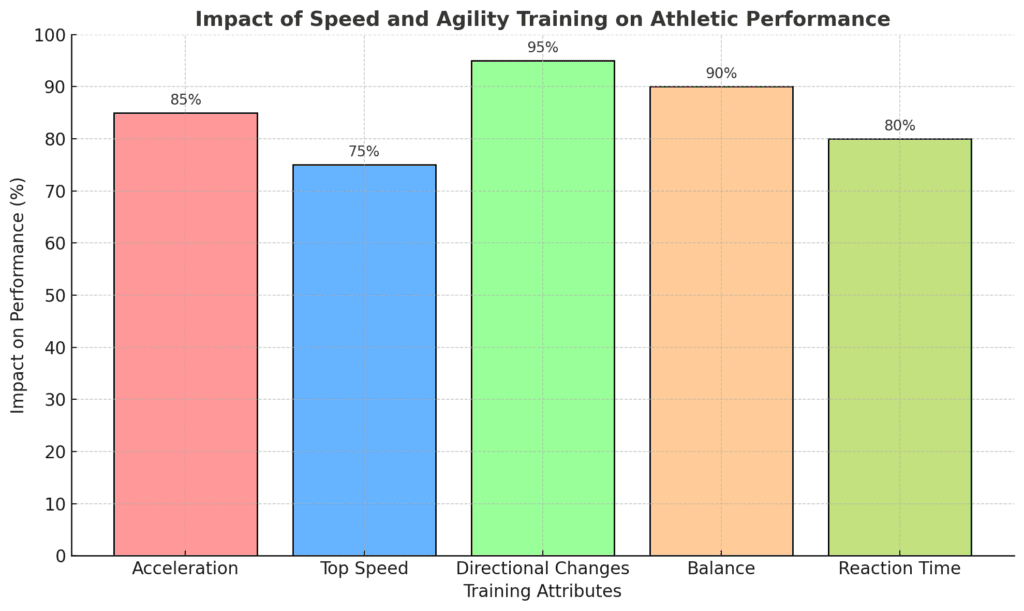
The Science Behind Speed and Agility Training
Understanding the science behind speed and agility training can help you make the most of your workouts and improve your performance. Let’s break it down into simpler terms to see how your body works and how you can train it effectively.
Biomechanics of Speed
When we talk about speed, we’re focusing on how quickly you can move from one place to another. Think of it like a racecar: to go fast, the car needs to have efficient mechanics and powerful engines. In human terms, this means efficient stride mechanics and force application.
Stride Mechanics: This is about how your legs move when you run. The more efficiently you move, the faster you go. Key components here are stride length (how far you travel with each step) and stride frequency (how often you take those steps). To sprint faster, you need to make each step count by pushing off the ground strongly and quickly.
Force Application: This involves how well your muscles generate power to move your body forward. Think of it as the engine in your racecar. Strong, well-coordinated muscle contractions are essential for high-speed running. When you sprint, your muscles need to work together to propel you forward efficiently.
Practical Example: Sprinting 100 meters as fast as you can is a good way to see speed in action. Your goal is to cover that distance in the shortest time possible, which relies on having powerful and efficient stride mechanics.
Biomechanics of Agility
Agility is about how quickly you can change direction while keeping control of your movements. Imagine playing a game of tag and needing to suddenly dodge someone coming toward you. That’s agility in action.
Quick Changes in Direction: To be agile, you need to be able to speed up, slow down, and turn quickly. This requires strong neuromuscular coordination, which is basically how well your brain and muscles communicate to perform these rapid changes.
Maintaining Balance: When you change direction quickly, you must stay balanced to avoid falling or losing control. This is why agility training often involves drills that challenge your balance and control while you move fast.
Practical Example: Navigating a series of cones in a zig-zag pattern helps you practice changing direction quickly while maintaining balance and control. It’s a great way to improve your agility in a controlled environment.

Muscle Groups for Speed and Agility
Speed: The muscles you use most for speed are called fast-twitch muscle fibers. These are the muscles that help you perform explosive movements, like sprinting. To strengthen these fibers, focus on exercises like sprints and resistance training.
Agility: Agility requires a mix of strength, flexibility, and endurance. Important muscle groups include the quads (front of the thighs), hamstrings (back of the thighs), glutes (buttocks), and core (abdomen and lower back). A balanced workout that targets these muscles will help improve your agility.
Neuromuscular Coordination
Neuromuscular Coordination is how well your brain communicates with your muscles. For both speed and agility, this coordination is crucial. Think of it like a symphony: all parts need to work together smoothly. When you train, you’re not just building muscle; you’re also improving how quickly and efficiently your brain can send signals to your muscles.
Training Tips
To make the most of speed and agility training, you need to target both speed and agility in your workouts. Here’s how:
For Speed: Include high-intensity sprints and resistance exercises. These will help strengthen your fast-twitch muscle fibers and improve your stride mechanics.
For Agility: Incorporate drills that involve quick changes in direction, like cone drills and ladder exercises. These drills improve your balance, coordination, and ability to accelerate and decelerate quickly.
The science behind speed and agility training involves understanding how your body moves and responds. Speed depends on efficient stride mechanics and strong muscle contractions. Agility relies on quick changes in direction, balance, and coordination. By focusing on the right muscle groups and improving neuromuscular coordination, you can enhance both speed and agility. Incorporate targeted exercises into your routine to see improvements in your athletic performance and overall physical capabilities.
Practical Exercises for Speed in Speed and Agility Training
When it comes to speed and agility training, improving your speed is a key component. Speed doesn’t just mean running fast in a straight line; it’s also about how quickly you can accelerate, maintain top speed, and recover. To help you get faster, here are some practical exercises that target different aspects of speed. These exercises are designed to be easy to follow and effective for both beginners and more experienced athletes.
Sprints: A Classic for Speed Development
Sprints are one of the simplest and most effective ways to improve speed. When you sprint, you’re pushing your body to move as quickly as possible, which builds explosive power in your muscles and enhances your overall speed. There are two main types of sprints you can focus on, each targeting different aspects of speed.

Short Sprints (20-30 meters): These are great for improving acceleration, which is how fast you can go from standing still to moving at full speed. If you’re looking to improve how quickly you can explode off the starting line, short sprints should be a core part of your routine. Acceleration is especially useful in sports like football, basketball, or soccer, where you often need to make short, fast bursts.
Longer Sprints (60-100 meters): These help develop your top speed—the fastest you can run once you’ve accelerated. Long sprints challenge your endurance at high speed and help you maintain that speed for longer periods, which is essential for sports that require you to sprint longer distances.
Example Drill: One simple but effective sprint drill is to perform 10×30 meter sprints. Start from a standstill, sprint as fast as you can for 30 meters, then take a full recovery between each sprint—walking back to your starting point, catching your breath, and making sure you’re fully rested before the next sprint. Focus on explosive starts, pushing hard from your first step, and maintaining maximum speed throughout the sprint. This will help improve both your acceleration and your top-end speed.
Hill Sprints: Adding Resistance to Build Power
Running on flat ground is one thing, but running up a hill adds extra resistance, which forces your body to work harder and builds greater power in your legs. Hill sprints are a fantastic exercise for enhancing both speed and explosiveness. When you sprint uphill, the incline naturally makes it harder for your muscles to propel your body forward, which trains them to produce more force. This extra strength translates into faster sprints when you’re back on flat ground.
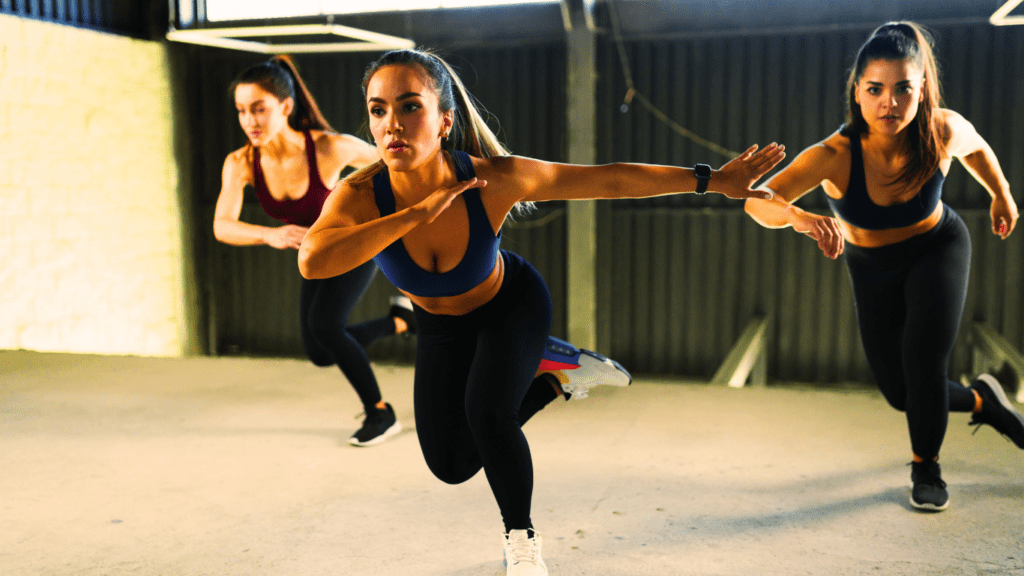
Description: To perform hill sprints, find a hill with a steep incline—ideally between 30 to 45 degrees. The steeper the hill, the more challenging the sprint, so pick one that matches your current fitness level. The goal here is to sprint up the hill with maximum effort for a short burst of time, about 15 to 20 seconds, and then recover by walking or jogging back down.
Example Drill: Sprint uphill for 15-20 seconds at full speed. After you reach the top, take your time walking or jogging back down the hill to recover fully before repeating. Aim to do this 8-10 times. Hill sprints are great for improving both leg strength and cardiovascular fitness, making them a valuable part of any speed and agility training program.
Resistance Sprints: Strengthening Muscles for More Explosive Speed
If you want to take your sprints to the next level, adding resistance is an excellent way to push your body harder and build even more strength. Resistance sprints involve attaching weight or resistance to your body, such as using a sled, resistance bands, or a parachute. The added resistance forces your muscles to work harder, which builds power and speed. Resistance sprints are especially helpful for improving the force you can generate when you take off from a standstill.
Description: There are different tools you can use for resistance sprints. A simple way to add resistance is by using a resistance band. Attach one end of the band to a stationary object, such as a pole or a wall, and then wrap the other end around your waist. As you sprint forward, the resistance band pulls back, making it harder for you to run, which builds strength in your legs and core.

Example Drill: Start by attaching a resistance band to a solid object. Sprint forward for 10-15 seconds, pushing against the resistance of the band. The harder the band pulls, the more power you’ll need to exert. After each sprint, take a full recovery before starting again. Aim for 8-10 repetitions. This drill is a fantastic way to build both speed and strength simultaneously, as it forces your muscles to work harder than they would in a normal sprint.
These exercises—sprints, hill sprints, and resistance sprints—are key components of effective speed and agility training. They target different aspects of speed, from acceleration and top speed to explosive power and strength. By incorporating these practical drills into your routine, you’ll improve not just your running speed, but also your overall athletic performance.
Whether you’re an athlete looking to gain an edge in your sport, or just someone who wants to get faster for personal fitness, focusing on these speed drills will help you reach your goals. Remember, speed and agility training is about consistent practice and pushing your limits over time. Stick with it, and you’ll see noticeable improvements in how fast and powerful you can move.
Practical Exercises for Agility
Agility is just as important as speed when it comes to improving athletic performance. While speed is about moving fast in a straight line, agility focuses on your ability to change directions quickly and stay balanced during those changes. This is especially crucial in sports like basketball, soccer, tennis, and football, where quick reactions and sharp movements make a big difference. Below are some practical exercises you can include in your routine to enhance agility. These exercises are simple yet effective, helping to improve your footwork, coordination, and explosive power.
Cone Drills: Enhancing Footwork and Quick Direction Changes
Cone drills are an excellent way to boost your agility because they help you practice quick, controlled movements and sharp direction changes. These drills are easy to set up and are ideal for athletes of all levels. By practicing cone drills regularly, you’ll develop better footwork and be able to react more swiftly during your sport or workout.

Description: The idea behind cone drills is to set up a few cones and move between them as fast as possible while keeping your balance and form. These drills challenge your ability to move laterally, accelerate, and decelerate quickly, making them great for overall agility.
Example Drill: One of the most effective cone drills is the T-Drill. To set this up, arrange 5 cones in a T-shape. Start at the base of the T (the first cone). Sprint forward to the top cone, shuffle left to the side cone, shuffle right to the opposite cone, and finally shuffle back to the base. This movement pattern forces you to change direction rapidly and maintain control of your body while moving at high speed. Aim to perform 3-5 sets of this drill, focusing on speed and accuracy. As you improve, try to complete the drill faster while keeping your form sharp.
Ladder Drills: Improving Foot Speed and Coordination
Agility ladders are another excellent tool for developing agility. These drills are designed to improve your foot speed, coordination, and balance—all of which are important for quick direction changes. Ladder drills encourage you to move fast while paying close attention to your foot placement, which helps build better control and coordination over time.
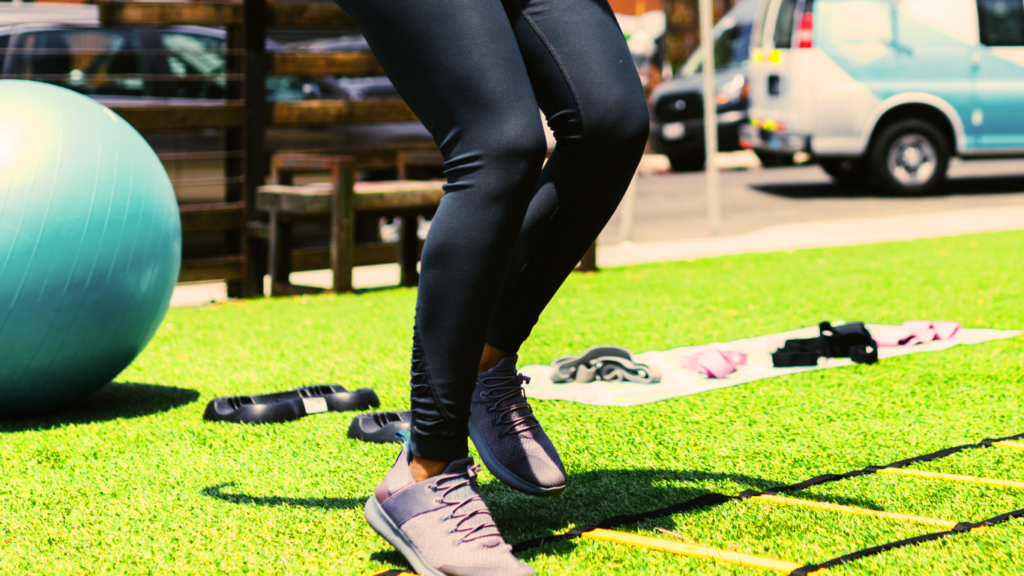
Description: Agility ladders are flat, portable tools that you place on the ground. The goal is to move your feet in and out of the ladder’s rungs as quickly as possible, practicing light, quick movements. These drills help enhance coordination and foot speed, making your movements more efficient.
Example Drill: A common ladder drill is the In-and-Out Drill. To perform this drill, step into the first rung of the ladder with one foot, then the other foot, and quickly step both feet out before moving to the next rung. Keep your movements quick and controlled. Aim to complete 3 sets of 20 seconds each, focusing on maintaining your speed while stepping accurately. As you improve, you can add more challenging patterns, such as side-to-side movements or hops, to increase the complexity of the drill.
Plyometrics: Building Explosive Power and Agility
Plyometric exercises are designed to develop your ability to generate force quickly, which is crucial for agility. Plyometrics involve explosive movements, like jumping or bounding, which challenge your muscles to stretch and contract rapidly. These exercises are excellent for enhancing both power and agility, as they mimic the fast, sharp movements needed in sports and other activities.
Description: Plyometric exercises focus on generating explosive power by incorporating movements that challenge your muscles to stretch and contract quickly. These exercises improve not only agility but also your balance and coordination.
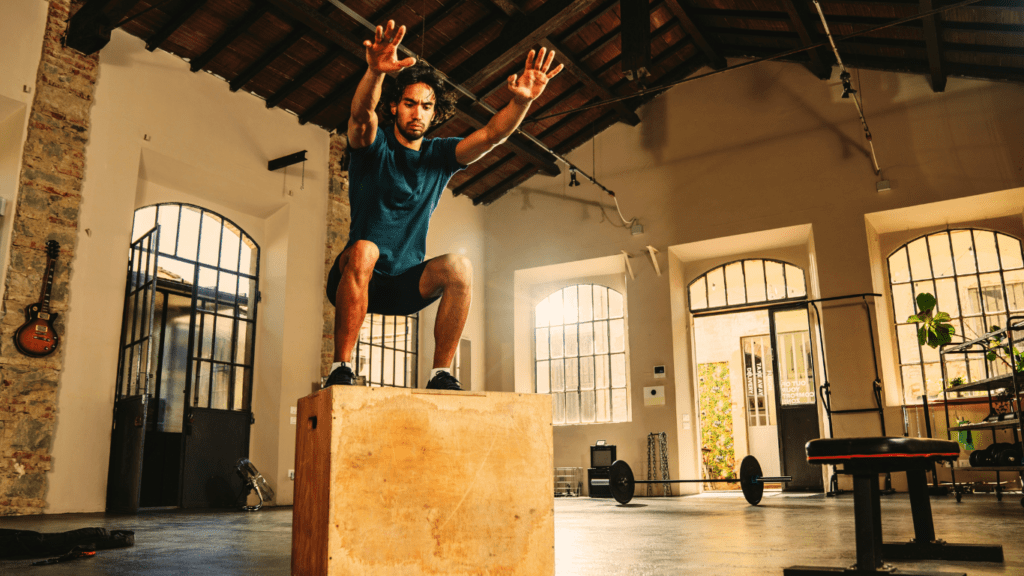
Example Drill: A simple yet effective plyometric exercise for agility is the Box Jump. To perform a box jump, stand in front of a sturdy box or platform. Jump explosively onto the box, landing softly with both feet, then step down and repeat. The key is to focus on power and control—jump as high as you can while maintaining proper form. Aim to complete 3 sets of 10 jumps, focusing on explosive power during the jump and a controlled landing.
Incorporating cone drills, ladder drills, and plyometric exercises into your routine is a surefire way to improve your agility. These exercises are designed to help you move faster, change direction more quickly, and stay balanced while doing so. Agility is a key component in many sports and daily activities, and by practicing these drills regularly, you’ll notice improvements in your overall athletic performance. Whether you’re an athlete or just looking to get fitter, focusing on agility will give you the quickness and control needed to excel.
Integrating Speed and Agility Training into Your Routine
When it comes to improving your athletic performance, speed and agility training can make a significant difference. But just like with any other training method, the key to success lies in how you incorporate these exercises into your overall fitness routine. This section will guide you through essential elements like warm-ups, cool-downs, frequency, recovery techniques, and common mistakes to avoid, so you can make the most out of your speed and agility training.
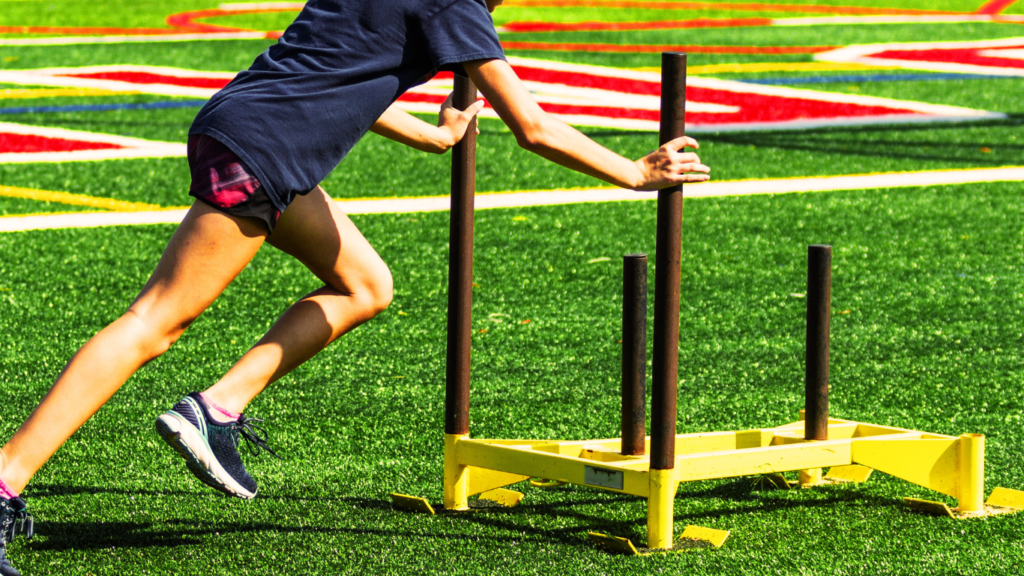
Warm-Up and Cool-Down: Preparing and Recovering Effectively
Before jumping into any intense speed and agility training session, a proper warm-up is crucial. Warming up not only prepares your body physically but also primes your nervous system for the quick, sharp movements you’ll be doing. Without a good warm-up, your risk of injury increases, and your overall performance may suffer.
Warm-Up: To get ready for speed and agility training, focus on dynamic stretches. These types of movements are different from static stretches, which are better saved for the end of your workout. Dynamic stretches increase blood flow to your muscles and improve your range of motion, making your body ready for fast, explosive movements. Some effective dynamic stretches include leg swings, high knees, and butt kicks. Aim for 5-10 minutes of dynamic stretches before starting your workout to ensure your muscles are warmed up and your joints are prepared for rapid direction changes.
Once your speed and agility training session is over, it’s time to help your body cool down and recover properly. A cool-down helps your heart rate return to normal and aids in preventing muscle stiffness the next day.
Cool-Down: After training, spend some time doing static stretching. Unlike dynamic stretches, static stretches involve holding positions for about 20-30 seconds to gradually lengthen your muscles. Focus on key areas like your hamstrings, quads, calves, and hip flexors—muscles that worked hard during your agility and speed drills. Incorporating foam rolling into your cool-down can also help to release muscle tension and improve circulation, reducing soreness and aiding in recovery.
Frequency and Volume: How Often Should You Train?
When it comes to speed and agility training, balancing frequency and intensity is essential. Overdoing it can lead to burnout or injury, while too little training won’t give you the results you’re looking for.
A general guideline for speed and agility training is to aim for 2-3 sessions per week. Training more than this can increase the risk of overuse injuries, particularly if you’re also involved in other high-intensity sports or strength training. It’s important to give your muscles and nervous system enough time to recover between sessions, so leave at least 48 hours between each session focused on speed and agility.
Incorporating variety into your training routine is another important aspect. Instead of repeating the same drills every session, mix up your exercises to prevent your body from adapting too quickly. For instance, one session might focus on short sprints and cone drills, while the next could include ladder drills and resistance sprints. This variety not only keeps your workouts engaging but also ensures that you’re improving different aspects of speed and agility, from explosive power to coordination and balance.
Recovery: The Key to Progress
One of the most overlooked aspects of any training routine is recovery. Without proper recovery, you’re unlikely to see the results you want, and you may even experience setbacks due to injury or fatigue.
Recovery Techniques: After a challenging speed and agility training session, your body needs time to repair and strengthen the muscles you’ve worked. Recovery is more than just resting; it’s about actively supporting your body to bounce back stronger. Active recovery, like light jogging, swimming, or even yoga, can help maintain blood flow to your muscles, which aids in removing lactic acid and speeds up recovery. This gentle movement helps to keep your muscles loose without overworking them.
Hydration and nutrition are also key factors in recovery. Make sure you’re drinking enough water before, during, and after your workouts. Staying hydrated ensures that your muscles remain flexible and helps reduce the risk of cramps. In terms of nutrition, focus on consuming protein and carbohydrates after your workout to fuel muscle repair and restore your energy levels. Foods like lean meats, fish, eggs, and whole grains are excellent choices for post-workout recovery meals.
Common Mistakes and How to Avoid Them
When integrating speed and agility training into your routine, there are some common mistakes that can hinder your progress or lead to injury. By being aware of these pitfalls, you can adjust your training to avoid them.
- Skipping the Warm-Up: One of the most common mistakes is diving straight into high-intensity drills without a proper warm-up. As mentioned earlier, a good warm-up is essential for priming your muscles and joints for quick, explosive movements. Without it, you increase the risk of injury and reduce your performance potential.
- Overtraining: Another frequent mistake is overtraining, or not giving your body enough time to recover between sessions. Training too often, or at too high an intensity, can lead to burnout, fatigue, and injury. Stick to the recommended frequency of 2-3 sessions per week and make sure to vary the intensity of your workouts to avoid overloading your muscles and nervous system.
- Focusing Too Much on One Aspect: It’s easy to get caught up in just practicing speed or just focusing on agility, but for the best results, you need a balance of both. A well-rounded routine incorporates drills that target speed, such as sprints and resistance runs, as well as drills that focus on agility, like cone drills and ladder drills. This way, you’ll develop both straight-line speed and the ability to change directions quickly and efficiently.
- Ignoring Recovery: Many people underestimate the importance of recovery. Skipping cool-downs, neglecting nutrition, or failing to stay hydrated can slow down your progress and lead to muscle soreness or injury. Always take time to recover properly after each session, whether it’s through active recovery, stretching, or ensuring you get enough nutrients and rest.
By following these guidelines and avoiding common pitfalls, you’ll be able to integrate speed and agility training into your routine effectively. This will not only improve your athletic performance but also enhance your overall fitness level, helping you move faster, react quicker, and stay more agile in both sports and daily life.
Key Benefits of Speed and Agility Training Exercises Chart:
The chart below breaks down the benefits of key exercises used in speed and agility training. It highlights how each type of exercise targets specific aspects of performance, including speed, power, and coordination, providing a clear guide to enhance your athletic development.
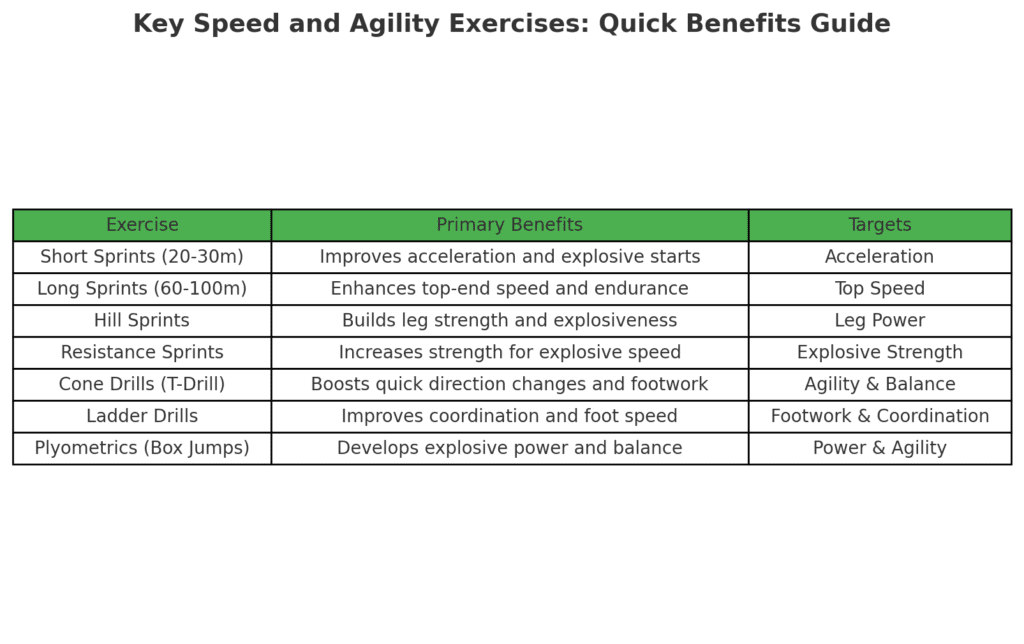
- Improved Acceleration:
- Exercises like short sprints and resistance sprints enhance the ability to quickly reach maximum speed from a stationary position.
- Beneficial for sports requiring explosive starts, such as football and basketball.
- Top Speed Development:
- Longer sprints (60-100m) focus on sustaining maximum speed over distance.
- Ideal for endurance sprinting in track events or soccer.
- Explosive Power:
- Hill sprints and plyometric drills (e.g., box jumps) train muscles to generate maximum force quickly.
- Helps with powerful starts and jumps in various sports.
- Quick Direction Changes:
- Cone drills and agility ladder exercises focus on lateral movement, balance, and coordination.
- Enhances performance in sports with rapid shifts, such as tennis and basketball.
- Enhanced Coordination and Balance:
- Ladder drills improve precise footwork and body control during fast movements.
- Vital for maintaining agility during complex movements on the field or court.
- Strengthened Muscles:
- Resistance sprints add load, building muscle power for stronger strides.
- Helps improve overall running mechanics and force application.
This breakdown highlights the versatility and specific benefits of the exercises, helping readers understand how each contributes to overall speed and agility development.
Common Mistakes and How to Avoid Them
When incorporating speed and agility training into your workout routine, it’s easy to make certain mistakes that can hinder progress or even cause injuries. While this type of training is highly beneficial, like anything else in fitness, it requires a careful and balanced approach to achieve optimal results. In this section, we’ll discuss some common mistakes people make in speed and agility training, along with practical tips on how to avoid them.
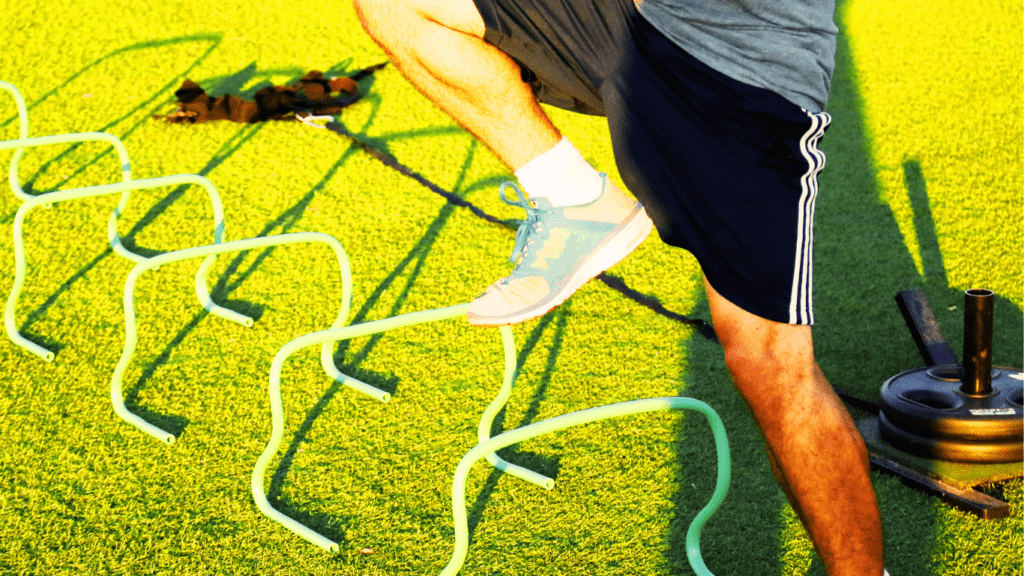
Overtraining: Striking the Right Balance
One of the biggest mistakes people make in speed and agility training is overtraining. It’s tempting to push yourself hard every day, thinking that more work equals better results. However, the body needs time to rest and recover between intense workouts, especially when you’re focusing on exercises that require explosive power and quick movements. If you don’t give your muscles and nervous system enough time to recover, you risk burnout, injury, and diminished performance.
How to Avoid Overtraining: Listen to your body. If you feel constantly fatigued, have sore muscles that don’t seem to recover, or notice a dip in performance, these are signs that you may be overtraining. A good rule of thumb is to limit speed and agility training to 2-3 sessions per week, with at least 48 hours of rest between sessions. These recovery days are vital for muscle repair and growth, so don’t skip them. You can still engage in light exercises like walking, stretching, or swimming on your off days to promote active recovery without overloading your muscles.
Also, be sure to vary the intensity of your workouts. Not every session needs to be at maximum effort. Mixing high-intensity sessions with moderate or low-intensity drills allows your body to build endurance and strength without overwhelming it.
Improper Form: The Foundation of Safe Training
Another common mistake is focusing on speed and intensity at the expense of proper form. In speed and agility training, it’s essential to perform exercises with correct technique to avoid injury and get the most out of your workouts. Whether you’re sprinting, doing ladder drills, or working with resistance, improper form can lead to strains, sprains, and long-term injuries, especially in joints like the knees, ankles, and hips.
How to Avoid Improper Form: Start slow and build up speed gradually. Before you aim for top speeds or fast agility movements, make sure you’re comfortable with the movements at a slower pace. Work on proper foot placement, body alignment, and balance first. If possible, train under the supervision of a coach or trainer who can provide real-time feedback on your form. If you don’t have access to a coach, using mirrors or recording your training sessions can be useful for spotting and correcting mistakes on your own.
Another useful tip is to focus on the quality of your movements over quantity. In speed drills, for example, rushing through the exercise without paying attention to your body mechanics can lead to poor technique. Always prioritize form and precision before trying to increase speed or add intensity to your training.
Neglecting Flexibility: The Key to Agility
Flexibility is a crucial but often overlooked component of speed and agility training. Without good flexibility, you won’t be able to move through a full range of motion, which is essential for changing directions quickly and efficiently. Tight muscles and stiff joints limit your ability to execute fast, agile movements and can even lead to injuries if not addressed. For example, tight hip flexors or hamstrings can significantly hinder your sprinting performance, while a lack of flexibility in the ankles can affect your ability to pivot or turn quickly.
How to Avoid Neglecting Flexibility: Incorporate stretching and mobility exercises into your regular routine. Dynamic stretching before your workout and static stretching after your session are essential steps to prevent injury and improve your range of motion. Dynamic stretches like leg swings or arm circles before training help warm up the muscles, while static stretches like holding a hamstring stretch or quad stretch after training allow your muscles to relax and lengthen.
For agility exercises, it’s particularly important to focus on flexibility in areas like the hips, ankles, and shoulders, which are frequently used in quick changes of direction or lateral movements. Adding yoga or mobility-focused workouts to your routine a few times a week can improve your flexibility and help you move more fluidly during your speed and agility drills.
Failing to Warm Up and Cool Down: Don’t Skip the Essentials
Another mistake that athletes often make is skipping the warm-up or cool-down. Jumping straight into high-intensity drills without preparing your muscles and joints can drastically increase your risk of injury. On the other hand, finishing a tough workout without cooling down can leave your muscles tight and sore, which might slow down your recovery and affect your next training session.
How to Avoid Skipping Warm-Ups and Cool-Downs: Before every speed and agility training session, allocate at least 5-10 minutes to warming up with dynamic stretches. This gets your blood flowing to the muscles and improves your range of motion. Exercises like walking lunges, leg swings, and high knees are great dynamic stretches that prepare your muscles for high-intensity work.
After your workout, always include a cool-down period. This helps to gradually bring your heart rate back to normal and prevents your muscles from becoming too stiff. Focus on static stretching for the major muscle groups you used during your workout, such as your hamstrings, quads, and calves. Adding a foam rolling session can also help to release tight muscles and improve blood flow for recovery.
Inconsistent Training: The Key to Progress is Consistency
One of the biggest mistakes people make is not staying consistent with their speed and agility training. Whether it’s skipping workouts due to a busy schedule or not progressing with more challenging drills, inconsistency can make it difficult to see real improvement. Speed and agility are skills that take time to develop, and without regular training, you may not reach your full potential.
How to Avoid Inconsistent Training: Create a plan and stick to it. Schedule your speed and agility training sessions into your week just like you would any other important appointment. Consistency is what builds muscle memory and helps you refine your technique. Even if you can only fit in a shorter session, it’s better to keep up with your routine than to skip the workout entirely.
Also, be sure to progress your workouts over time. Once you’ve mastered a basic drill, challenge yourself with a more advanced version or add resistance to increase difficulty. This keeps your training sessions fresh and ensures you’re continually improving.
By avoiding these common mistakes—overtraining, improper form, neglecting flexibility, skipping warm-ups and cool-downs, and being inconsistent—you’ll be able to get the most out of your speed and agility training. Focus on balance, proper technique, and listening to your body to prevent injuries and improve your performance. The key to success is not just hard work but smart work, and with the right approach, you’ll see noticeable improvements in your speed, agility, and overall athletic ability.
Life Application and Success Stories
When it comes to sports performance, the importance of speed and agility can’t be overstated. Whether it’s making that last-second dash for the ball or quickly changing direction to outmaneuver an opponent, these skills often separate the good from the great. Let’s look at a few real-life stories of athletes from around the world who transformed their abilities through dedicated speed and agility training.
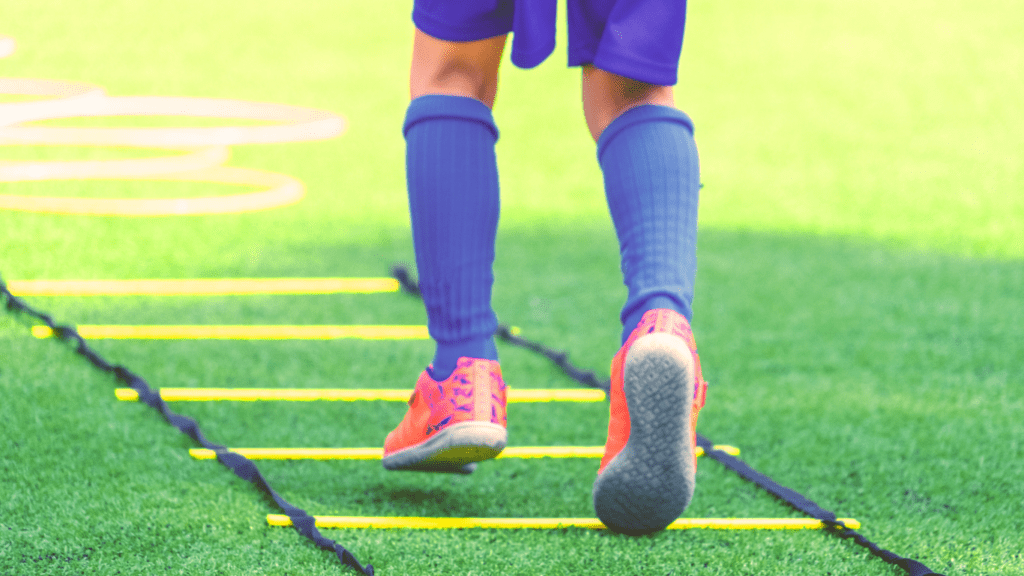
Carlos: The Soccer Player Who Became a Game-Changer
Carlos, a soccer player from Spain, always had solid ball-handling skills and a sharp mind for the game. However, he noticed his speed and ability to change direction were lacking compared to his competitors. In a fast-paced sport like soccer, where quick bursts of speed and agility are essential for success, Carlos knew he needed to improve in these areas if he wanted to level up his game.
His coach recommended speed and agility training, focusing on drills like cone zig-zags, shuttle runs, and resistance sprints. Within a few months of practicing these exercises several times a week, Carlos saw remarkable improvements. His acceleration off the mark became faster, and his agility allowed him to make sharp turns without losing balance or momentum.
As a result, Carlos became one of the most dynamic players on his team, consistently outrunning opponents and gaining a competitive edge on the field. His enhanced agility also helped him react more quickly to opponents, making him more unpredictable and dangerous during matches. Through consistent speed and agility training, Carlos completely transformed his game, earning him recognition as a standout player in his league.
Emily: The Tennis Prodigy Who Gained a New Edge
Emily, a promising young tennis player from Australia, had excellent technique but found herself struggling during longer rallies. Her lack of quickness to chase balls that required fast lateral movement and sudden changes in direction was preventing her from reaching her full potential. Tennis is a game where agility plays a key role, as players must move swiftly around the court, responding to balls hit at various speeds and angles.
Emily’s coach introduced her to speed and agility training, tailoring drills to the specific demands of tennis. She began performing ladder drills to improve footwork and acceleration, as well as plyometric exercises like box jumps to enhance her explosiveness. Over time, she became faster, more agile, and more confident in her movements across the court.
After several months of training, Emily’s game dramatically improved. She was able to chase down shots that would have previously been out of reach, making her far more competitive during matches. Her increased agility allowed her to maintain balance while stretching for difficult shots, and her improved speed enabled her to play more aggressive, offensive tennis. This physical transformation gave her the tools she needed to compete at a higher level, and soon she was winning tournaments and climbing up the rankings.
Jamal : The Basketball Player Who Improved His Court Presence
Jamal, a high school basketball player from the United States, had always been a skilled shooter, but his ability to move quickly on defense and navigate tight spaces on offense was holding him back. In basketball, where split-second decisions and movements are key, being both fast and agile can make a huge difference in a player’s performance.
After a few disappointing games, Jamal’s coach suggested that he begin a speed and agility training program. The focus was on improving his lateral quickness with side shuffles and his sprint speed for fast breaks. Jamal also incorporated drills with resistance bands to improve his explosiveness when jumping for rebounds and layups.
After weeks of dedicated work, Jamal saw big changes. He was not only faster in getting down the court but was also able to anticipate and react more quickly on defense. His agility improved so much that he could weave through defenders with ease, creating more scoring opportunities. Jamal’s newfound speed and agility made him a more well-rounded player, helping his team win more games and catching the attention of college scouts.
Maya : The Runner Who Found a Competitive Edge
Maya, a long-distance runner from Kenya, excelled in endurance but struggled when it came to short bursts of speed during races. Whether it was a sprint finish or navigating crowded packs of runners, she found herself outmatched by faster, more agile competitors. Maya’s coach recommended incorporating speed and agility training into her program, even though she initially thought it was more suited to sprinters or team athletes.
She started with short sprints to build acceleration and included agility drills to improve her ability to make quick adjustments when running in tight groups. Hill sprints and resistance band work became a regular part of her training routine to boost her power.
Over time, Maya noticed significant improvements. Her finishing sprints became faster, allowing her to close the gap on competitors in the final moments of races. Additionally, her enhanced agility helped her navigate around other runners more effectively, improving her overall race strategy. With these improvements, Maya began placing higher in competitions, proving that speed and agility training is not just for sprinters, but can benefit endurance athletes as well.
Lukas : The Handball Player Who Took His Game to the Next Level
Lukas, a handball player from Germany, faced challenges with his reaction time and quick directional changes during matches. In handball, players must constantly move in different directions, often in confined spaces, while maintaining control over the ball. Lukas realized that his lack of agility was limiting his ability to defend and attack effectively.
To address this, Lukas incorporated speed and agility training into his routine, working on cone drills, ladder exercises, and plyometrics. This training helped him improve his ability to react quickly and change direction without losing balance.
The results were undeniable. Lukas became faster and more agile, allowing him to respond more quickly to opponents’ moves and create more opportunities for his team. His improved agility also made him a more effective defender, enabling him to block passes and intercept the ball with greater ease. His performance on the court was transformed, earning him a reputation as one of the top players in his league.
These stories of athletes from different sports and countries highlight how speed and agility training can unlock new levels of performance. Whether you’re a soccer player, a tennis enthusiast, a runner, or a basketball player, training your body for speed and agility can help you reach your full potential. The physical improvements not only boost your abilities in your chosen sport but also increase your confidence, allowing you to perform at your best when it matters most.
Bringing It All Together: The Final Word on Speed and Agility Training
Did you know that elite athletes can reach speeds of up to 27 miles per hour? That’s faster than the average city speed limit! Now, while we may not all be breaking land speed records, there’s no reason why speed and agility training can’t help us move a little faster and change directions a little more smoothly in our own lives. And hey, who knows—maybe after this, you’ll be the fastest one darting through the grocery store aisles!
On a more serious note, as we’ve discussed throughout this article, speed and agility training isn’t just for professional athletes. It’s a crucial part of improving overall fitness, boosting performance in everyday activities, and, of course, excelling in sports. Whether you’re a soccer player, a weekend runner, or just someone who wants to improve their movement efficiency, working on speed and agility will benefit you in ways you might not expect. Let’s recap why this is so important and how you can start making these exercises part of your regular routine.

Why Speed and Agility Matter
If you’ve been following along, you already know that speed refers to how fast you can move from point A to point B, while agility is all about your ability to quickly change direction and maintain control over your movements. These skills are essential, not just for athletes, but for everyone. Being quick on your feet doesn’t just help on the playing field; it can also help you avoid accidents, improve coordination, and increase your overall fitness level.
Improving speed can make everyday tasks more efficient, while greater agility helps you maintain balance and reduce the risk of falls. It’s about being more confident in your movements, whether you’re racing for a ball, going for a run, or simply trying to stay active as you get older. The principles of speed and agility training apply to every aspect of movement, from fast bursts of sprinting to sharp, controlled turns. These are the same skills that help top athletes achieve success in their sports, and they can help you achieve your personal fitness goals too.
Recap of Key Exercises
Throughout this article, we’ve covered some of the most effective exercises to boost both speed and agility. The beauty of these exercises is that they can be easily integrated into your existing routine, or serve as the foundation of a new one. Here’s a quick refresher on what you should focus on:
- Sprints: Short sprints help improve acceleration, while longer sprints develop top-end speed. Whether you’re training for a race or just want to increase your general fitness, these are the building blocks of speed.
- Hill Sprints: Running uphill builds power and explosiveness, which translates to improved speed on flat surfaces. It’s challenging but highly effective.
- Resistance Sprints: Using resistance bands or sleds during sprints helps improve strength and speed. This type of training adds intensity and makes you more powerful in your movements.
- Cone Drills: These drills focus on quick changes of direction, boosting agility and coordination. They’re great for athletes in sports that involve a lot of cutting, like basketball or soccer.
- Ladder Drills: Agility ladders develop foot speed, balance, and coordination. These drills are excellent for improving your overall agility and quickness.
- Plyometrics: Exercises like box jumps help build explosive power and agility. They’re essential for anyone looking to improve their ability to move quickly and with precision.
Now that you’ve got a handle on these exercises, the next step is figuring out how to make them part of your training routine.
Integrating Speed and Agility Training Into Your Routine
The best way to incorporate speed and agility training is by keeping things simple but consistent. You don’t need to dedicate hours each day to see progress—just a few sessions a week can lead to noticeable improvements.
Here’s a motivational tip: start by setting aside two or three days a week specifically for speed and agility work. You can blend these sessions into your existing workout routine or dedicate separate days to them. The key is variety and consistency. Avoid doing the same drills every session—mix up sprints, agility ladder drills, and cone exercises to keep your body guessing and prevent burnout. And remember, recovery is just as important as training. Make sure to allow at least 48 hours between intense speed and agility sessions to give your muscles time to repair and grow stronger.
Imagine how you’ll feel after just a few weeks of this training—more confident in your movements, faster in your runs, and more agile in your everyday activities. The results don’t just show up on the field or court, but in every aspect of your life. Think about how much more efficient and powerful you’ll feel when your body is trained to react quickly and move with purpose.
Start Now and Share Your Journey
At this point, you have everything you need to start improving your speed and agility. But it doesn’t stop here! The real growth happens when you put these principles into practice. Think about it: each sprint you run, each agility drill you master, gets you one step closer to reaching your personal goals—whether that’s outperforming your teammates, improving your fitness, or simply moving better in everyday life.
Here’s where it gets fun: we want to hear about your progress. Are you noticing faster sprint times? Can you change direction quicker? Do you feel more balanced and in control? Share your journey, your wins, and even your struggles. The road to improving speed and agility is not always easy, but it’s incredibly rewarding. By sharing your experiences, you’ll not only motivate yourself but inspire others to start their own journey.
In the end, speed and agility training isn’t just about getting faster or more agile—it’s about unlocking a new level of confidence and capability in everything you do. Whether you’re chasing your fitness goals, competing in sports, or just looking to move better, this type of training is a game-changer. So, lace up those shoes, get moving, and start building a faster, more agile version of yourself today.
And remember: no one ever regretted getting faster—unless they forgot to hit the brakes!


